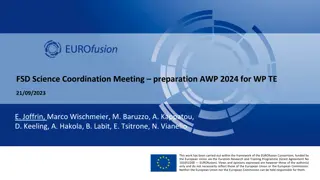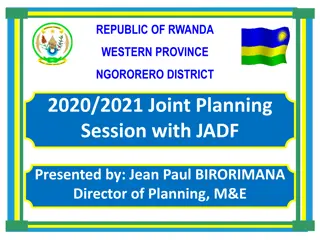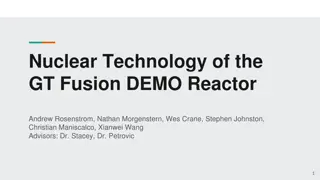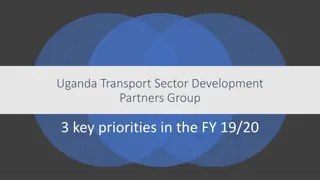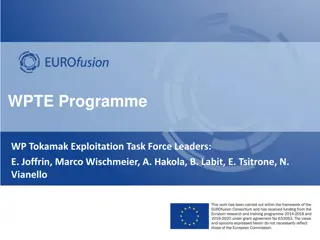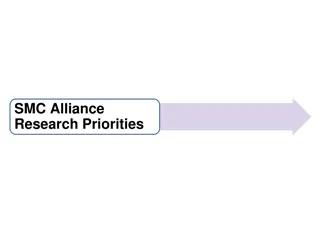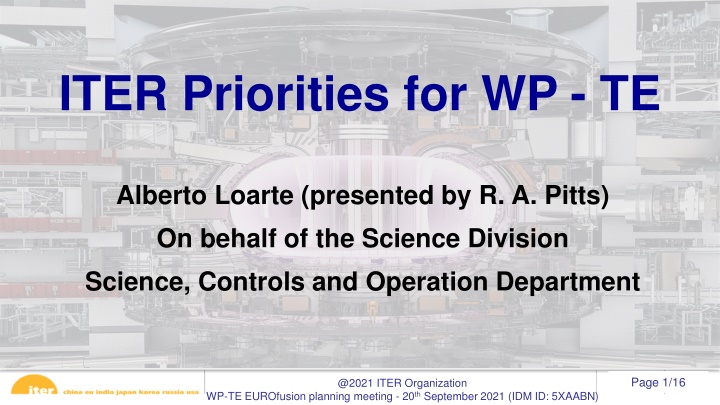
ITER Research Priorities for WP-TE: Supporting Fusion Development
Explore the research priorities outlined for the ITER project, including areas such as disruption characterization, plasma-material interactions, and scenario control. High-priority R&D topics for the next few years are highlighted to support the project's baseline design and operational goals. Stay informed on the latest developments shaping the future of fusion technology.
Download Presentation

Please find below an Image/Link to download the presentation.
The content on the website is provided AS IS for your information and personal use only. It may not be sold, licensed, or shared on other websites without obtaining consent from the author. If you encounter any issues during the download, it is possible that the publisher has removed the file from their server.
You are allowed to download the files provided on this website for personal or commercial use, subject to the condition that they are used lawfully. All files are the property of their respective owners.
The content on the website is provided AS IS for your information and personal use only. It may not be sold, licensed, or shared on other websites without obtaining consent from the author.
E N D
Presentation Transcript
ITER Priorities for WP - TE Alberto Loarte (presented by R. A. Pitts) On behalf of the Science Division Science, Controls and Operation Department Page 1/16 @2021 ITER Organization WP-TE EUROfusion planning meeting - 20thSeptember 2021 (IDM ID: 5XAABN)
Outline of talk R&D priorities to support ITER Research Plan Priorities for WP-TE Conclusions Page 2/16 @2021 ITER Organization @2021 ITER Organization WP-TE EUROfusion planning meeting - 20th September 2021 (IDM ID:5XAABN) WPSA EUROfusion planning meeting - 8th September 2021
R&D Topics for IRP R&D for design completion (DMS, Diagnostics, etc.) Disruption characterization, prediction and avoidance Stationary H-mode plasmas, ELMs, ELM control and impact on H-mode and power fluxes Characterization and control of stationary power fluxes Plasma material/component interactions and consequences for ITER operation Start-up, ohmic and L-mode scenario development Conditioning, fuel inventory control Basic scenario control and commissioning of control systems Transient phases of scenarios and control Complex scenario control during stationary phases Validation of scenario modelling and analysis tools Heating and Current Drive and fast particle physics Long pulse/enhanced confinement scenario issues Page 3/16 @2021 ITER Organization WP-TE EUROfusion planning meeting - 20th September 2021 (IDM ID:5XAABN)
Categories for IRP R&D issues Categories 1 Outcome of R&D can have major impact on system design or on the ITER Research Plan (e.g. modifying overall experimental strategy in each phase or the objectives of the phases themselves) 2 Outcome of R&D expected to have medium impact on system design or on the ITER Research Plan (e.g. modifying significant details of experimental strategy to achieve objectives in each phase) 3 Outcome of R&D expected to optimize details of ITER Research Plan experimental strategy to achieve objectives in each phase by providing relevant experience Page 4/16 @2021 ITER Organization WP-TE EUROfusion planning meeting - 20th September 2021 (IDM ID:5XAABN)
High Priority Cat. 1 and Cat. 2 R&D Topics (next ~ 3 years) Support of DMS baseline design (Shattered Pellet Injection, SPI) Resolution of diagnostic design issues He H-mode operation and/or H+10% He operation for Pre-Fusion Power Operation 3rd harmonic ECH heating validation for 1.8 T operation in PFPO Low <ne> ECH heated H-modes for operation in PFPO-1 Electron Cyclotron Wall Conditioning (ECWC) for use in PFPO-1 ECH-assisted and ohmic start-up for First Plasma (FP) and PFPO-1 Disruption loads characterization in PFPO Strategy for ELM control n = 1 and n = 2 error fields and correction Divertor lifetime appropriateness to allow operation until well into the Fusion Power Operation (FPO) phase with the first tungsten divertor 3-D field ELM suppressed H-mode as integrated scenario for ITER high Q scenarios Specific issues for Q = 5 steady-state scenarios in ITER with NBI + ECH Page 5/16 @2021 ITER Organization WP-TE EUROfusion planning meeting - 20th September 2021 (IDM ID:5XAABN)
Support to DMS (SPI) design DMS design next steps are PDR in 2022 and FDR in 2024 to be ready for installation and exploitation by start of PFPO-1 A.1. SPI-single injector. Pellet injection optimization for RE avoidance (incl. TQ and CQ mitigation) optimization of shard size, velocity, amount, gas vs. shard fraction, composition (D + impurity) to achieve RE avoidance with optimum TQ, CQ (incl. wall loads) A.2. SPI-single injector demonstration for runaway mitigation the energy of formed runaway beams (amount, assimilation) and to improve scheme determination of feasibility to dissipate A.3. SPI-multiple injections avoidance with optimum TQ, CQ (incl. wall loads) compared to single injections (incl. timing requirements) determination of effectiveness of multiple injections to achieve RE A.10. SPI-single injector. Pellet injection geometry optimization for RE avoidance (incl. TQ and CQ mitigation) optimization of injection direction to achieve RE avoidance with optimum TQ, CQ (incl. wall loads) Page 6/16 @2021 ITER Organization WP-TE EUROfusion planning meeting - 20th September 2021 (IDM ID:5XAABN)
He and H + 10% He operation in PFPO Additional heating level to plasma in PFPO makes H-mode operation in hydrogen not possible or marginal operational space (H + 10% He could be an alternative) B.2.1. He H-mode operation with W PFCs and ELM control pedestal behaviour, ELM control and W operational issues (W accumulation, PWI issues) with D H-modes (highest priority with 3-D fields, but other ELM control schemes such as hydrogen pellet pacing and vertical movements are also important) He H-modes provide robust Compare He H-mode plasmas with W PFCs B.2.2. Mixed H + ~ 10 % He H-mode operation and ELM control. Establish H H-mode plasmas with a range of He concentrations to determine the requirements for H-mode access and sustainment and for ELM control schemes compared to H plasmas B.4.1. Be wall erosion in He plasmas wall erosion leads to coating of the divertor He plasma discharges to determine if expected increased of Be B.4.2. He plasma modification of W mechanical properties at high fluences PFCs to He plasmas and characterization of exposed PFCs Long-term exposure of W B.4.3. Formation of fuzz by He/W interaction and critical fuzz thickness plasmas, measurement of fuzz and impact on plasma operation Exposure of W PFCs to He Page 7/16 @2021 ITER Organization WP-TE EUROfusion planning meeting - 20th September 2021 (IDM ID:5XAABN)
3rd harmonic ECH heating validation for 1.8 T operation in PFPO B.11.6. Validation of models for ECH absorption in 3rd harmonic operation at 5 MA/ 1.8 T plasmas Quantitative experimental evidence on 3rd harmonic absorption in conditions similar to those in 5 MA / 1.8 T plasmas and validate modelling predictions (PFPO-1 H-modes) Perform ITER-like experiments with 3rd harmonic ECH absorption and study the temporal increase of the absorption for various levels of ECH powers Modelling of 1.8 T ITER scenarios: M. Schneider, et al., NF 2019 start in plasmas with low ~ 10-20% Page 8/16 @2021 ITER Organization WP-TE EUROfusion planning meeting - 20th September 2021 (IDM ID:5XAABN)
Low <ne> ECH heated H-modes for operation in PFPO-1 B.2.4. H-mode access and confinement of H plasmas with electron heating and low plasma density in PFPO-1 Evaluate H-mode access and confinement in ITER-like H plasmas for PFPO with dominant electron heating Plasma in PFPO-1 H-modes: A. Loarte, et al., NF 2021 ITER - 1.8 T 30 min He PLH PLH PLH(@0.5nGW) PLH(@0.5nGW) 25 min H 20 PLH (MW) 15 10 5 0 3 4 5 Ip(MA) Page 9/16 @2021 ITER Organization WP-TE EUROfusion planning meeting - 20th September 2021 (IDM ID:5XAABN)
Electron Cyclotron Wall Conditioning (ECWC) for use in PFPO-1 B.6.1 ECWC conditioning Perform ECWC conditioning and determine requirements for effective cleaning (and reliable plasma start-up including recovery from unmitigated and mitigated disruptions) Use ECRH for ECWC on a routine basis for general machine conditioning (and disruption recovery) and diagnose the ECWC plasma ECWC is one of the two cleaning techniques available in ITER with toroidal field on and only one available in PFPO-1 Page 10/16 @2021 ITER Organization WP-TE EUROfusion planning meeting - 20th September 2021 (IDM ID:5XAABN)
ECH-assisted and ohmic start-up for First Plasma (FP) and PFPO-1 Plasma start-up requires validated models both for ECH assisted and ohmic start- up Vloop~0.3 V/m due to SC coil voltage limits and VV B.5.1. ECH assisted plasma start-up Perform experiments to optimize ECRH assisted start-up and to validate models for ITER B.5.2. Ohmic plasma start-up Perform experiments to achieve ohmic plasma start up in ITER-like conditions (i.e. electric field) and identify the range of parameters over which this can be most reliably achieved High quality measurements during plasma start-up are essential MA Ip Ir Rpl,uOhm 50(Zeff-1) q 0.35 MA Ip Ir Rpl,uOhm 50(Zeff-1) q 100 0.5 0.3 MA TRANSMAK-SCENPLINT 0.3 mPa Ip Ir Rpl,uOhm TRANSMAK-SCENTPLINT 0.7 mPa 50(Zeff-1) q 100 0.35 0.4 80 100 80 0.25 0.3 80 0.2 0.25 0.3 60 60 0.2 0.15 60 40 0.15 0.2 40 0.1 40 0.1 0.1 20 0.05 20 20 0.05 t,s t,s t,s t,s t,s t,s 0 0 0 1.1 1.3 1.3 1.2 gz 1.4 1.3 1.5 1.4 1.6 1.5 1.6 1.1 1.2 1.3 1.4 1.5 1.6 1.1 1.1 1.2 1.2 1.3 1.3 1.4 1.4 1.5 1.5 1.6 1.6 1.1 1.1 1.2 1.2 1.4 1.7 1.5 1.6 1.7 0.2 0.2 gz gz tE,s tE,s tE,s Page 11/16 @2021 ITER Organization 0.5 0.5 0.15 0.2 0.5 0.15 WP-TE EUROfusion planning meeting - 20th September 2021 (IDM ID:5XAABN) 0.4 0.4 0.4 0.15 0.1 0.3 0.3 0.1 0.3 0.1 0.2 0.2 0.05 0.2 0.1 0.1 0.05 0.05 t,s t,s 0 0 0.1 t,s t,s 1.1 1.2 1.3 1.4 1.5 1.6 1.1 1.2 1.3 1.4 1.5 1.6 0 0 t,s t,s 0 0 1.1 1.2 1.3 1.4 1.5 1.6 1.7 1.1 1.2 1.3 1.4 1.3 1.5 1.4 1.6 1.5 1.7 1.1 1.2 1.6 1.1 1.2 1.3 1.4 1.5 1.6
Disruption load characterization B.1.1. Disruption/VDE thermal load characterization thermal loads during TQ and CQ (magnitude, time dependence and distribution) Characterization of B.1.2. Disruption/VDE mechanical load (current flow) characterization including toroidal rotation Characterization of halo currents during disruptions and VDEs (magnitude, time dependence and distribution, including rotation) B.1.3. Runaway electron load characterization. Characterization of power deposition to PFCs by runaway plasmas (magnitude, time dependence and distribution, including magnetic to kinetic energy conversion in termination) Page 12/16 @2021 ITER Organization WP-TE EUROfusion planning meeting - 20th September 2021 (IDM ID:5XAABN)
3-D field ELM suppressed H-mode as integrated scenario for ITER high Q Emphasis on scenario integration aspects (incl. physics-based scaling to ITER) B.2.10. ELM control by 3-D fields with low input torque and moderate ratios of Pinput/PLH (incl. access/exit) B.2.11. Impurity (W) exhaust for ELM control by 3-D fields in stationary H-modes and its optimization B.3.2. Effect of plasma response on divertor power fluxes with 3-D fields for ELM control and 3-D field optimization and B.3.5. Effect of 3-D fields for ELM control on divertor power fluxes in radiative H-modes. B.11.3. Evaluate fast particle losses with 3-D fields and their correlation with plasma response and ELM control Page 13/16 @2021 ITER Organization WP-TE EUROfusion planning meeting - 20th September 2021 (IDM ID:5XAABN)
3-D field ELM suppressed H-mode as integrated scenario for ITER high Q B.3.2 Effect of plasma response on divertor power fluxes with 3-D fields for ELM control and 3-D field optimization Determine effect of plasma response to 3-D fields on the spatial structure and magnitude of toroidally asymmetric divertor power fluxes with 3-D fields for ELM control and optimization to maximize wetted area Required to determine the spatial structure of divertor power fluxes in ITER and to identify the physics basis on which to extrapolate experimental results to ITER taking into account the plasma response expected to be required High density divertor with 3-D fields in PFPO-1 H-modes: H. Frerichs, et al., PRL 2021 Page 14/16 @2021 ITER Organization WP-TE EUROfusion planning meeting - 20th September 2021 (IDM ID:5XAABN)
Conclusions WP-TE is a major contributor to R&D to support IRP on multiple areas Focus for 2022 on specific high priority topics with high impact on IRP (overall and specifically for PFPO-1) Support of DMS baseline design (Shattered Pellet Injection, SPI) He H-mode operation and/or H+10% He operation for Pre-Fusion Power Operation 3rd harmonic ECH heating validation for 1.8 T operation in PFPO Low <ne> ECH heated H-modes for operation in PFPO-1 Electron Cyclotron Wall Conditioning (ECWC) for use in PFPO-1 ECH-assisted and ohmic start-up for First Plasma (FP) and PFPO-1 Disruption loads characterization in PFPO 3-D field ELM suppressed H-mode as integrated scenario for ITER high Q scenarios Page 15/16 @2021 ITER Organization WP-TE EUROfusion planning meeting - 20th September 2021 (IDM ID:5XAABN)


